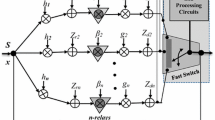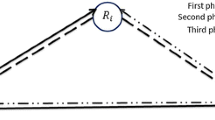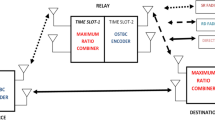Abstract
In this paper, we propose the analytical approach for amplify-and-forward (AF) opportunistic relaying schemes (ORS). When operation of AF-ORS consists of relay selection and data transmission phases based on pilot symbol assisted-channel estimation (PSA-CE) methods over quasi-static Rayleigh fading channels, we show that the relay selection phase can be implemented by pilots symbols transmission for source-relay and relay-destination. Moreover, the feedback method for the selected relay index is proposed to have a simple fashion. Then, we investigate the effects of both a channel estimation error and an estimated noise variance, which are obtained by PSA-CE methods, on the received signal-to-noise ratio (SNR). The average SNR loss is also derived in terms with the number of pilots in PSA-CE methods. Moreover, the average symbol error rate, the outage probability, and the normalized channel capacity of the ORS are derived in approximated closed-form expressions for an arbitrary link SNR when the channel state information in the source-relay-destination link is estimated based on transmitted pilots symbols. As the number of pilot symbols, the derived analytical approach is verified, and by comparing it with simulation results, the accuracy is demonstrated. In addition, it is verified that the effect of the feedback error can be neglected for PAS-CE methods over quasi-static fading channels.







Similar content being viewed by others
References
Hasna, M. O., & Alouini, M.-S. (2003). End-to-end performance of transmission systems with relays over Rayleigh-fading channels. IEEE Transactions on Wireless Communications, 2(6), 1126–1131.
Laneman, J. N., Tse, D. N. C., & Wornell, G. W. (2004). Cooperative diversity in wireless networks: efficient protocols and outage behavior. IEEE Transactions on Information Theory, 50(12), 3062–3080.
Jang, J., & Ko, K. (2011). Exact & closed-form BER expressions based on error—events at relay nodes for DF relay systems over Rayleigh fading channels. IEICE Transactions on Communications, E94–B(08), 2419–2422.
Anghel, P. A., & Kaveh, M. (2004). Exact symbol error probability of a cooperative network in a Rayleigh-fading environment. IEEE Transactions on Wireless Communications, 3(9), 1416–1421.
Bletsas, A., Khisti, A., Reed, D. P., & Lippman, A. (2006). A simple cooperative diversity method based on network path selection. IEEE Journal on Selected Areas in Communications, 24(3), 659–672.
Park, S., Park, H., & Kim, E.-J. (2014). Distributed relay-assisted retransmission scheme for wireless home networks. International Journal of Distributed Sensor Networks, 10, 683146.
Lee, S., Han, M., & Hong, D. (2009). Average SNR and ergodic capacity analysis for opportunistic DF relaying with outage over rayleigh fading channels. IEEE Transactions on Wireless Communications, 8(6), 2807–2812.
Sagong, S., Lee, J., & Hong, D. (2011). Capacity of reactive DF scheme in cognitive relay networks. IEEE Transactions on Wireless Communications, 10(10), 3133–3138.
Ko, K., & Woo, C. (2012). Outage probability and channel capacity for Nth best relay selection AF relaying over INID Rayleigh fading channels. International Journal of Communication Systems, 25(11), 1496–1504.
Nam, S., Ko, K., & Hong, D. (2012). Exact average SER performance analysis for the Nth best opportunistic amplify-and-forward relay systems. IEICE Transactions on Communications, E95–B(5), 1852–1855.
Ko, K., & Woo, C. (2013). More accurate ASER bound for opportunistic amplify-and-forward relay systems. Wireless Personal Communications, 68(3), 609–617.
Mi, H., Ge, J., & Shi, X. (2015). Power allocation for cognitive two-way AF relay networks with asymmetric traffic requirements. Wireless Personal Communications, 84(4), 2723–2733.
Zhang, T., Chen, W., & Cao, Z. (2015). DNF-AF selection two-way relaying. Wireless Personal Communications, 80(2), 805–818.
Ko, K., Seo, J., & Woo, C. (2011). Another closed-form expression of average error rate for the Nth best relay selection AF relaying over rayleigh fading channels. In Proceedings of international conference on ICT convergence (ICTC 2011) (pp. 106–109). Seoul, Korea, September 28–30, 2011.
Ko, K., & Woo, C. (2013). More tractable average error rate expression for the Nth best relay selection scheme of DF relaying over Rayleigh fading channels. International Journal of Communication Systems, 25(10), 1356–1364.
Ko, K., & Woo, C. (2013). Performance analysis and simulations for opportunistic one-way amplify-and-forward cooperative relay networks. Journal of Computational and Theoretical Nanoscience, 10(08), 1802–1807.
Han, S., Ahn, S., Eunsung, O., & Hong, D. (2009). Effect of channel-estimation error on BER performance in cooperative transmission. IEEE Transactions on Vehicular Technology, 58(4), 2083–2088.
Vicario, J., Bel, A., Lopez-Salcedo, J., & Seco, G. (2009). Opportunistic relay selection with outdated CSI: Outage probability and diversity analysis. IEEE Transactions on Wireless Communications, 8(6), 2872–2876.
Kim, S., Park, S., Min, H., & Hong D. (2011). Average snr and ergodic capacity of reactive df relaying system with outdated channel state information. In Proceedings of IEEE ICC (pp. 1–5). Kyoto, Japan, June 5–9, 2011
Seyfi, M., Muhaidat, S., Liang, J., & Dianati, M. (2011). Effect of feedback delay on the performance of cooperative networks with relay selection. IEEE Transactions on Wireless Communications, 10(12), 4161–4171.
Kim, S., Park, S., & Hong, D. (2013). Performance analysis of opportunistic relaying scheme with outdated channel information. IEEE Transactions on Wireless Communications, 12(2), 538–549.
John, G. (1995). Proakis: Digital communication (3rd ed.). New York City: McGraw Hill.
Simon, M. K., & Alouini, M.-S. (2000). Digital communication over fading channels. Hoboken: Wiley.
Ikki, S. S., & Ahmed, M. H. (2008). Performance of multiple-relay cooperative diversity systems with best relay selection over Rayleigh fading channels. EURASIP Journal on Advances in Signal Processing, 2008, 580368. doi:10.1155/2008/580368.
Maham, B., & Hjorungnes, A. (2009). Performance analysis of amplify-and-forward opportunistic relaying in Rician fading. IEEE Signal Processing Letters, 16(8), 643–646.
Ikki, S. S., & Ahmed, M. H. (2009) On the performance of amplify-and-forward cooperative diversity with the nth best-relay selection scheme. In Proceedings of IEEE ICC (pp. 1–6). Dresden, Germany, June 14–18, 2009
Ikki, S. S., & Ahmed, M. H. (2007). Performance analysis of cooperative diversity wireless networks over Nakagami-m fading channel. IEEE Communications Letters, 11(4), 334–336.
Ikki, S. S., & Ahmed, M. H. (2010). On the performance of cooperative-diversity networks with the nth best-relay selection scheme. IEEE Transactions on Communications, 58(11), 3062–3069.
Ko, Kyunbyoung, & Seo, Jeongtae (2011) On outage probability and channel capacity for the Nth best opportunistic ADF relay systems. In Proceedings of international conference on ICT convergence (ICTC 2011) (pp. 245–249). Seoul, Korea, September 28–30, 2011.
Gradshteyn, I. S., & Ryzhik, I. M. (1994). Table of integrals, series and products (5th ed.). San Diego: Academic Press.
Evolved Universal Terrestrial Radio Access (E-UTRA). Further advancements for E-UTRA physical layer aspects (3GPP TR 36.814 V9.0.0.).
Duong, T. Q., & Zepernick, H.-J. (2009). On the performance gain of hybrid decode-amplify-forward cooperative communications. EURASIP Journal on Wireless Communications and Networking, 2009, 479463. doi:10.1155/2009/479463.
Author information
Authors and Affiliations
Corresponding author
Additional information
This research was supported by Basic Science Research Program through the National Research Foundation of Korea (NRF) funded by the Ministry of Science, ICT & Future Planning (2013R1A1A1A05008009, 2017R1A2B4012883) and by the MSIT (Ministry of Science and ICT), Korea, under the ITRC (Information Technology Research Center) support program (IITP-2017-2013-0-00680) supervised by the IITP (Institute for Information & communications Technology Promotion).
Appendices
Appendix 1: Approximated Value of S–R Link’s Estimated Noise Variance
By using the estimated channel coefficient \(\hat{h}_{i}\) of (2) and the known pilot symbols \(\left\{ s^p|_{p=1}^{N_P} \right\}\), the estimated noise variance for the pilot symbol transmission can be written as Eq. (3) and \(y_{i}^p - {\hat{h}_{i}} s^p\) can be presented as
with \(\hat{h}_{i} = \frac{1}{N_P}\sum _{p=1}^{N_P} {s^{p}}^* y_{i}^p = h_{i} \sqrt{E_i} + e_{i}\) and \(e_{i} = \frac{1}{N_P}\sum _{p=1}^{N_P} {s^{p}}^* n_{i}^p\). Note that (53) has \(N_P\) independent AWGN terms \(\left\{ n_{i}^{p}|_{p=1}^{N_P} \right\}\). Therefore, it leads to
with \(E\left[ n_{i}^p \right] =0\) and \(E\left[ |n_{i}^p|^2 \right] =\sigma ^2\) for \(p\in \{1,2,\ldots ,N_P\}\). Note that \(\sigma _{P,i}^{2}\) of (54) is used for the approximated value of \({\hat{\sigma }}_{P,i}^{2}\) in (3).
Appendix 2: Approximated Value of R–D Link’s Estimated Noise Variance
From (5), (6), and (7), the channel estimation error of the ith indirect link can be represented as
with \(\frac{1}{N_P} \sum _{p=1}^{N_P} |s^p|^2 = 1\) and \(e_{i} = \frac{1}{N_P}\sum _{p=1}^{N_P} {s^{p}}^* n_{i}^p\). In \(e_{L+i}=\frac{1}{N_P}\sum _{p=1}^{N_P} {s^{p}}^* n_{L+i}^p\), the CEE term related with S–R link (i.e., \(e_{i}\)) is eliminated and then, \(e_{L+i}\) is only related with R–D link’s noise terms \(\left\{ n_{L+i}^p|_{p=1}^{N_P} \right\}\). Therefore, we can easily obtain \(E[e_{L+i} ]=0\) and \(E[|e_{L+i}|^2]=\sigma ^2 / N_P\).
From (5), (6), and (7), we can obtain
and then, \(y_{L+i}^p\) is represented as
with \(y_{i}^p = h_{i} \sqrt{E_i} s^p + n_{i}^p\), \(G_{i} = \frac{\sqrt{E_{L+i}^{}}}{|\hat{h}_{i}|}\), \(\hat{h}_{i} = h_{i} \sqrt{E_i} + e_{i}\), \(\hat{h}_{L+i} = h_{L+i}^{'} + e_{L+i}\), \(e_{i} = \frac{1}{N_P}\sum _{p=1}^{N_P} {s^{p}}^* n_{i}^p\), and \(e_{L+i} = \frac{1}{N_P}\sum _{p=1}^{N_P} {s^{p}}^* n_{L+i}^p\). From (56), \(y_{L+i}^p - {\hat{h}_{L+i}} s^p\) in (8) can be expressed as
where both \(\left( - e_{L+i} s^p + n_{L+i}^p \right)\) and \(\left( -e_{i}s^p+n_{i}^p \right)\) are independent and have \(N_P\) independent AWGN terms of \(\left\{ n_{L+i}^{p}|_{p=1}^{N_P} \right\}\) and \(\left\{ n_{i}^{p}|_{p=1}^{N_P} \right\}\), respectively. Similar with (54), we can obtain
Consequently, for the given \(\hat{h}_{i}\) and \(\hat{h}_{L+i}\), it leads to
with
Note that \(\sigma _{P,L+i}^{2}\) of (59) is used for the approximated value of \({\hat{\sigma }}_{P,i}^{2}\) in (8).
Appendix 3: Derivation of \({\bar{\gamma }}_{\text {AF}_i}\)
By letting \(z=\frac{xy}{x+y}\), (36) can be rewritten as
Note that the lower limit of the integral related with y comes to the fact that the random variable of y is always greater than or equal to z (since \(x=yz/(y-z)\) must to be greater than or equal to 0, it is easy to see \(y \ge z\)) [10, 32]. Furthermore, the inner integral term in (60) can be regarded as the PDF of z and expressed as
with \(t=z/y\). Then, changing the order if the integrals of z and t, we can have
with \(\int _{0}^{\infty } z^2 e^{-Az} dz = 2A^{-3}\), \({A}^{-1} = \frac{ {\bar{\gamma }}_{i}{\bar{\gamma }}_{L+i}t(1-t) }{{\bar{\gamma }}_{i} + ({\bar{\gamma }}_{L+i}-{\bar{\gamma }}_{i})t}\), \(a={\bar{\gamma }}_{i}\), and \(b={\bar{\gamma }}_{L+i}-{\bar{\gamma }}_{i}\). Finally, it produces
and from (62) and (63), we can obtain \({\bar{\gamma }}_{\text {AF}_i}\) as (37).
Rights and permissions
About this article
Cite this article
Woo, C., Lim, S. & Ko, K. Effects of CEE and Feedback Error on Performance for AF-ORS with PSA-CE Schemes Over Quasi-Static Rayleigh Fading Channels. Wireless Pers Commun 97, 3619–3643 (2017). https://doi.org/10.1007/s11277-017-4689-y
Published:
Issue Date:
DOI: https://doi.org/10.1007/s11277-017-4689-y




